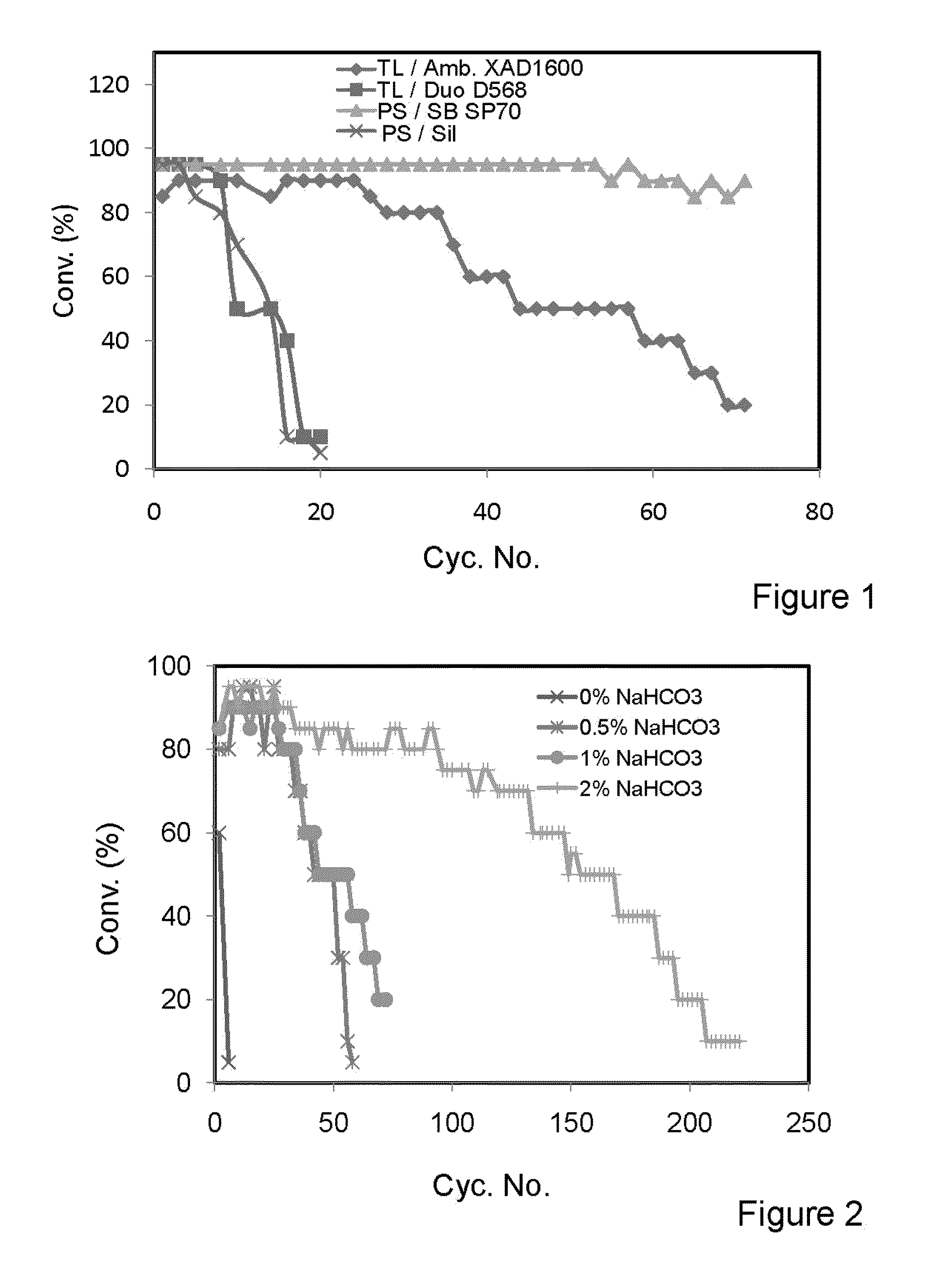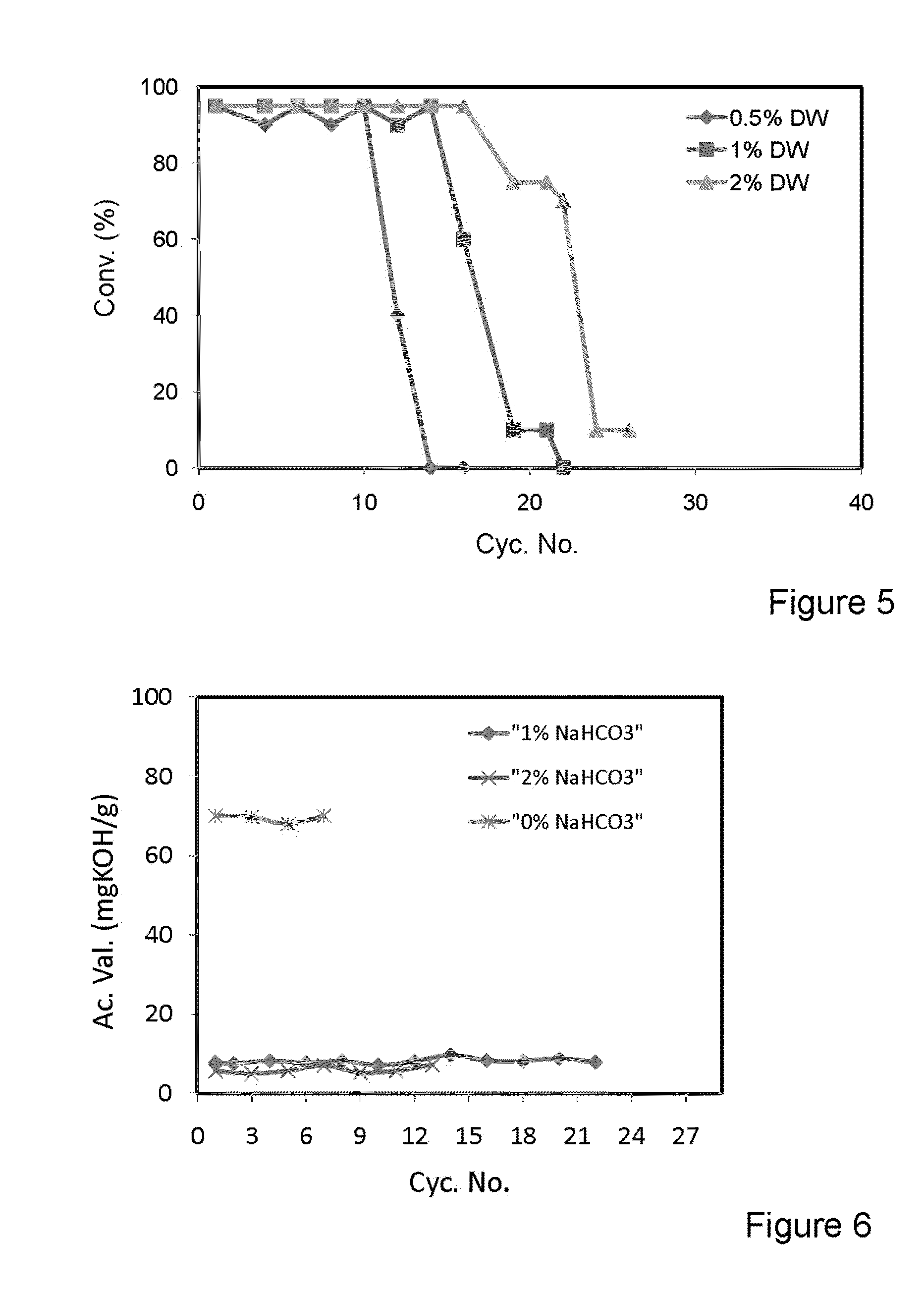Enzymatic transesterification/esterification processes employing lipases immobilized on hydrophobic resins in the presence of water solutions
a technology of hydrophobic resin and enzymatic transesterification, which is applied in the direction of biomass after-treatment, biofuels, enzyme production/based bioreactors, etc., and can solve the problems of affecting the stability unable to achieve the stabilization and cost-effectiveness of immobilized lipases, and most enzymes losing a significant portion of their synthetic activity
- Summary
- Abstract
- Description
- Claims
- Application Information
AI Technical Summary
Benefits of technology
Problems solved by technology
Method used
Image
Examples
example 1
[0126]The transesterification activity of lipase derived from Thermomyces lanuginosus immobilized on Amberlite® XAD 1600 as a hydrophobic resin and on Duolite® D568 as a hydrophilic resin, and lipase derived from Pseudomonas sp. immobilized on Sepabeads® SP70 as a hydrophobic resin and on porous silica as a hydrophilic resin.
[0127]Reaction Conditions:
[0128]Refined and bleached soybean oil (20 g) containing 1% wt. of sodium bicarbonate solution of 0.1M. Methanol (2.5 ml) was added stepwise in three equivalent batches each one hour apart. The reaction medium containing 10% wt. lipase preparation was shaken at 300 rpm and 30° C. Results are shown in FIG. 1.
[0129]The results presented in FIG. 1 show that both the Thermomyces lanuginosus and Pseudomonas sp. lipases immobilized on different resins in the presence of 1% wt. of sodium bicarbonate solution showed high transesterification activity during the first 5 cycles using the same batch of enzyme. It was observed that after the 5th bat...
example 2
[0130]A. The Conversion of Soybean Oil to Biodiesel and Glycerol after 6 Hours of Reaction Using the Same Batch of Biocatalyst in Multiple Batch Experiments.
[0131]Refined and bleached soybean oil (20 g) containing different concentrations of sodium bicarbonate solution of 0.1M. Methanol (2.5 ml) was added stepwise in three equivalent batches each one hour apart. Lipase derived from Thermomyces lanuginosus immobilized on a hydrophobic and porous polystyrene-divinylbenzene-based resin, was used (10% wt.). The reaction medium was shaken at 300 rpm and 30° C. Results are shown in FIG. 2.
[0132]B. The Conversion of Soybean Oil to Biodiesel and Glycerol after 6 Hours of Reaction Using the Same Batch of Biocatalyst in Multiple Batch Experiments.
[0133]Refined and bleached soybean oil (20 g) containing different concentrations of sodium bicarbonate solution of 0.1M. Methanol (2.5 ml) was added stepwise in three equivalent batches each one hour apart. Li...
example 3
[0135]A. The Conversion of Soybean Oil to Biodiesel and Glycerol after 6 Hours of Reaction Using the Same Batch of Biocatalyst in Multiple Batch Experiments.
[0136]Reaction Conditions:
[0137]Refined and bleached soybean oil (20 g) containing different concentrations of distilled water. Methanol (2.5 ml) was added stepwise in three equivalent batches each one hour apart. Lipase derived from Thermomyces lanuginosus immobilized on a hydrophobic and porous polystyrene-divinylbenzene-based resin, was used (10% wt.). The reaction medium was shaken at 300 rpm and 30° C. Results are shown in FIG. 4.
[0138]B. The Conversion of Soybean Oil to Biodiesel and Glycerol after 6 Hours of Reaction Using the Same Batch of Biocatalyst in Multiple Batch Experiments.
[0139]Reaction Conditions:
[0140]Refined and bleached soybean oil (20 g) containing different concentrations of distilled water. Methanol (2.5 ml) was added stepwise in three equivalent batches each one hour apart. Lipase derived from Pseudomona...
PUM
| Property | Measurement | Unit |
|---|---|---|
| temperature | aaaaa | aaaaa |
| temperature | aaaaa | aaaaa |
| temperature | aaaaa | aaaaa |
Abstract
Description
Claims
Application Information
 Login to View More
Login to View More - R&D
- Intellectual Property
- Life Sciences
- Materials
- Tech Scout
- Unparalleled Data Quality
- Higher Quality Content
- 60% Fewer Hallucinations
Browse by: Latest US Patents, China's latest patents, Technical Efficacy Thesaurus, Application Domain, Technology Topic, Popular Technical Reports.
© 2025 PatSnap. All rights reserved.Legal|Privacy policy|Modern Slavery Act Transparency Statement|Sitemap|About US| Contact US: help@patsnap.com



